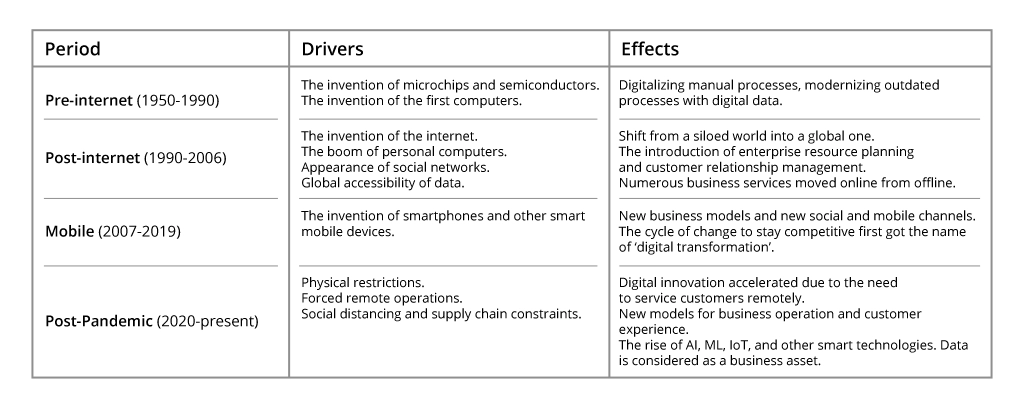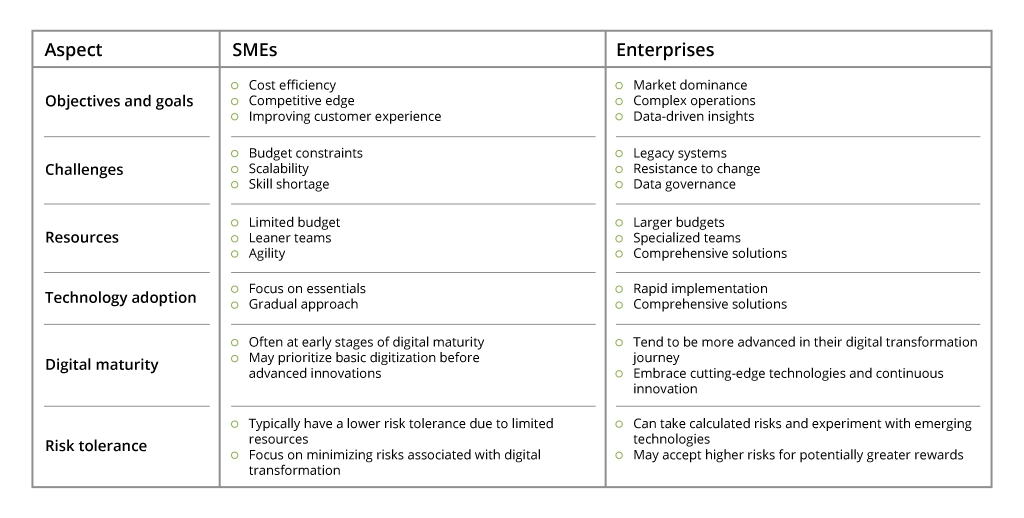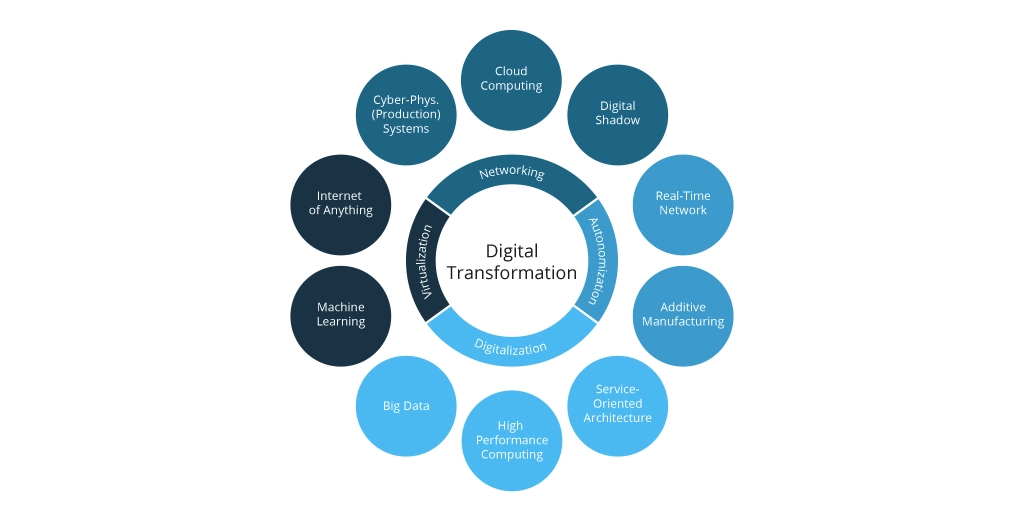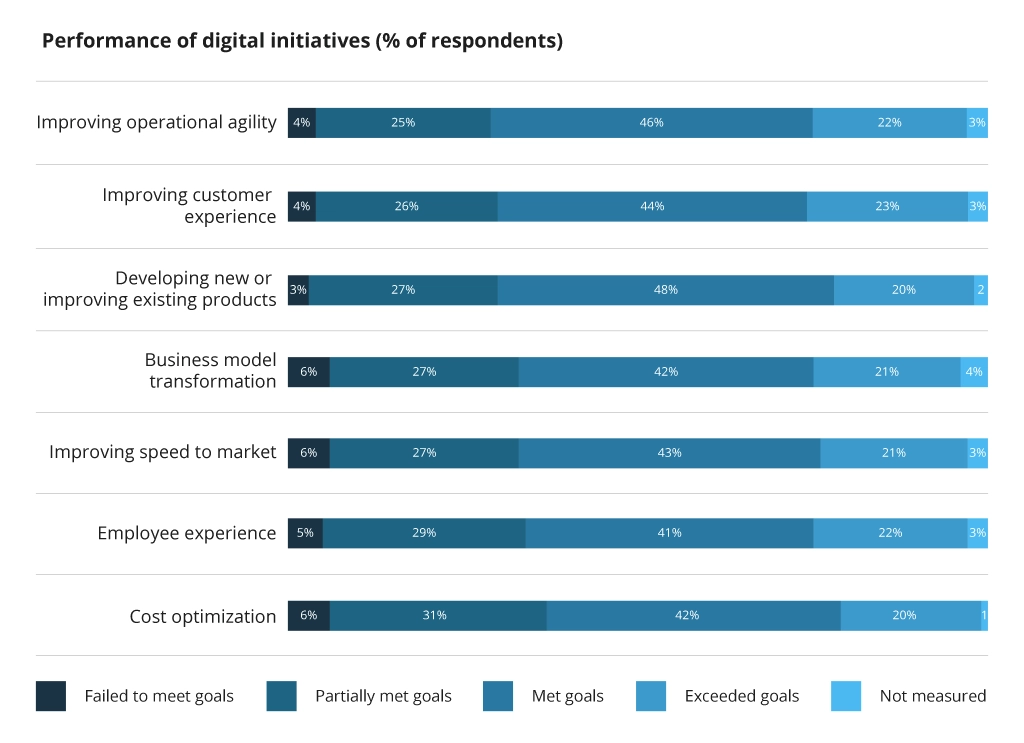What Does Digital Transformation Mean for Different Companies?
While digitization changes how organizations operate, the meaning of digital transformation also evolves with time. What does digital transformation entail today? What does it mean for businesses of different sizes?
In this article, we will analyze the purposes and scenarios of digital transformation for small, medium-size businesses and enterprises. We will go through the digital transformation drivers and a roadmap to harness technology based on specific business needs.
Digital transformation is defined as a process by which companies continuously embed technologies to drive fundamental changes in their operations, products, and service quality. The goal of digital transformation from the business point of view is creating value through deploying tech at scale.
For most companies, digital transformation means shifting from their traditional thinking and operation model to a more technological, innovative approach. Each big technological leap drives such ‘rethinking’, enabling a new stage of digital transformation.
The Evolution of Digital Transformation
The evolution of digital transformation has unfolded across four distinct eras, compelling companies to reshape their operations and customer service. Those unable to adapt often risk becoming obsolete, lagging behind competitors, or simply losing proposition. To understand better how digital transformation evolved with time, here is a short description of its four major periods:

As of now, the digital transformation has gained its peak speed. According to a recent survey by Deloitte, 98% of surveyed companies have started digital transformation, and 81% are satisfied with the transformation progress.
The survey by Deloitte defines the following goals business leaders pursue through their digital initiatives:
- Improving customer experience
- Developing or finetuning existing products
- Enhancing employee experience
- Improving operational agility
- Cost optimization
- Business model transformation
- Improving time to market.
The achievement rate for the goals above shows that modern tools and technologies are capable of covering the current business challenges of companies:
The survey respondents included businesses with the number of employees from <1,000 to >100,000. It points out that digital transformation is effective for companies of all sizes.
Traditionally, this term is related to some complex modernization of big enterprises. Yet, digital transformation applies to businesses of any scale. It can solve specific challenges and help realize certain goals. To understand it better, here are some real-world examples of how companies of different sizes implemented their digital transformation solutions:
- Small business: Agillic, an integrated marketing execution company, decided to modernize their SaaS application which would also allow automating marketing campaign management through all digital media channels. The solution developed by Infopulse has brought up a completely new approach to providing the company’s services and engaging customers. It resulted in faster time-to-market for new product releases, reduced cost of ownership, costs for customer care, and increased cross and up-sales.
- Mid-size business: HSN, the leading healthcare institution in Iceland, was looking for a more progressive yet cost-effective solution to automate their numerous operations to enhance productivity and employee satisfaction. Infopulse has developed a PoC of the RPA bot for HR reporting. Being satisfied with the PoC, HSN proceeded with the development of a fully-fledged RPA solution. As a result, the company automated 20+ HR and financial processes and reduced overall annual total cost (TC) expenses by 10+ million ISK. See the project roadmap and outcomes in the full digital transformation case study.
- Enterprise: A leading Ukraine-based group of metals and mining companies decided to implement a digital workplace solution for approximately 100,000 of employees across all departments. The Infopulse team developed a solution based on the Microsoft Azure Cloud platform which transformed the disparate systems that each group's company used into a single company-wide interface operating in the cloud. The solution significantly accelerated our client’s operations, enhanced the employee experience, and reduced infrastructure and support costs. Read the full case study to explore the implementation details.
Digital transformation for small business, medium-sized enterprises (SMEs), and large enterprises differs in several key aspects, including their objectives, challenges, resources, and strategies. Here's a comparison of digital transformation for SMEs and enterprises:
Digital Transformation for SMEs vs. Enterprises

SMEs and enterprises differ in their digital transformation approaches. SMEs prioritize cost-efficiency and compete through agility, while enterprises fight for market dominance and embrace more complex digital strategies. The companies choose different tools and solutions to achieve their business goals, based on the priorities. The choice of suitable digital transformation techniques also varies depending on the transformation drivers in every specific use case.
The Drivers of Digital Transformation
A company can evolve in numerous directions depending on what aspect should be improved. Here are the main decision-making drivers of digital transformation:
- Scale: The increasing number of customers requires the scalability of applications and infrastructure to maintain the business needs.
- Customer experience: Meeting the expectations of customers for seamless experiences across multiple channels and higher quality of service requires technological upgrades.
- Security: New technologies also give rise to new data security threats, which must be addressed with appropriate security enhancements.
- Agility: Businesses become more adaptive and flexible to respond quickly to market changes and customer needs. It all gives a competitive advantage. Check our case study for digital transformation in manufacturing that helped achieve all the above benefits.
- Remediation of technical debt: Legacy software limitations and high support expenses lead to switching to more advanced and cost-effective alternatives. Check our CTO’s guide for modernizing legacy systems to find out more.
- Insights: Advanced data analytics and processing help make more grounded business decisions, analyze risks accurately and make various predictions for appropriate production and sales planning.
- Speed: Streamlining operations and decision-making helps keep up with the growing industry demands, optimize costs, and create competitive advantage through faster time-to-market. For instance, digital transformation in banking helps accelerate service delivery and, therefore, win the customer from competitors. See the solution that streamlined credit approval for a large Nordic bank.
- Cost optimization: Automation reduces the manual effort and time required for executing operations resulting in tangible expense reduction. Our case of digital transformation in the automotive industry demonstrates the implementation of a VR learning platform for assembling and fixing vehicles. The solution helped reduce the costs of training service technicians and decrease the carbon footprint within the client’s sustainability strategy.
- Improving the digital culture: Enhancements in customer service, security, and operations help businesses enhance customer and employee loyalty.
The digital transformation can be driven by a combination of these factors, and one solution can cover several challenges a company wants to address. For example, Oracle FLEXCUBE implementation for Allianz Bank Bulgaria enhanced the scale of operations, customer experience, agility, and speed.
Defining the core drivers for changes helps build an effective roadmap for implementing the relevant advancements at optimum effort and budget.
Digital Transformation Roadmap
Digital transformation implies fundamental changes for the company that undergoes it. It often takes a lot of time and consumes significant resources. However, you can optimize this process with a proper approach.
Analyzing your business needs towards future changes and foreseeing potential outcomes will help focus on what needs to be done to achieve the desired goals and most importantly, it will allow minimizing risks. Follow these steps to design an effective digital transformation path for your company.
- Assess internal and external conditions
- Analyze external forces and trends
- Identify and prioritize customer and other stakeholder needs and goals
- Analyze digital technologies suitable for the defined goals
- Analyze current business and operating models, and cultural potential to changes
- Develop a strategy and assess business impacts
- Define different business scenarios
- Define technologies to be used
- Develop the to-be business model
- Develop a goal/objective hierarchy
- Analyze the business impact of the planned changes
- Architect a business solution
- Visualize the to-be business architecture
- Develop the to-be organizational culture and people practices
- Design the to-be organization structure
- Design the to-be value chain and processes
- Visualize the to-be IT architecture
- Pilot project
- Define a use case or more to implement a pilot
- Implement the architecture and functionalities for the chosen use cases
- Deploy the solution
- Evaluate the success of a pilot
- Document the results
- Scaling
- Define scaling objectives
- Allocate necessary resources to support the full-scale implementation
- Establish initiatives and deploy the solution
- Define and prioritize initiatives based on the objectives
- Create KPIs
- Establish a project plan
- Monitor your progress and deploy corrective measures
- Evaluate the success level
- Optimization and continious improvement
- Monitor the solution performance
- Regularly verify the solution to meet the changing business goals
- Implement the required improvements
A full understanding of all changes you plan to adopt and how they impact different parts and processes in the company is the core of successful digital transformation. Although this preparation phase takes time, it will significantly optimize the time and budget for the implementation and maximize the business benefits of digital transformation.
Conclusion
Digital transformation is a relatively new concept despite the extensive reliance among companies of all sizes globally. At its core, it means embedding new technologies to achieve specific business goals to optimize the current operations, develop new products and opportunities for growth, and competitive advantage on the market.
As the latest studies show, these transformations apply for any company type in any industry. To succeed, you need a digital transformation strategy relevant to your specific goals and enough expertise to implement the required changes effectively.
At Infopulse, we help compromise business goals with the solutions and technologies available today. We provide the full range of infrastructure modernization, intelligent business, and automation services for companies across industries.
If you are in search of the optimal digital transformation model for your business, Infopulse experts are ready to assist in both its strategizing and implementation.






![Digital Alignment Drivers [thumbnail]](/uploads/media/thumbnail-280x222-the-top-forces-driving-digital-alignment.webp)
![IoT as the Core of Digital Farming and Agriculture [thumbnail]](/uploads/media/280x222-iot-as-the-core-of-digital-farming-and-agriculture.webp)
![Digital Alignment Challenges [thumbnail]](/uploads/media/thumbnail-280x222-challenges-to-digital-alignment-and-digital-workplace.webp)




